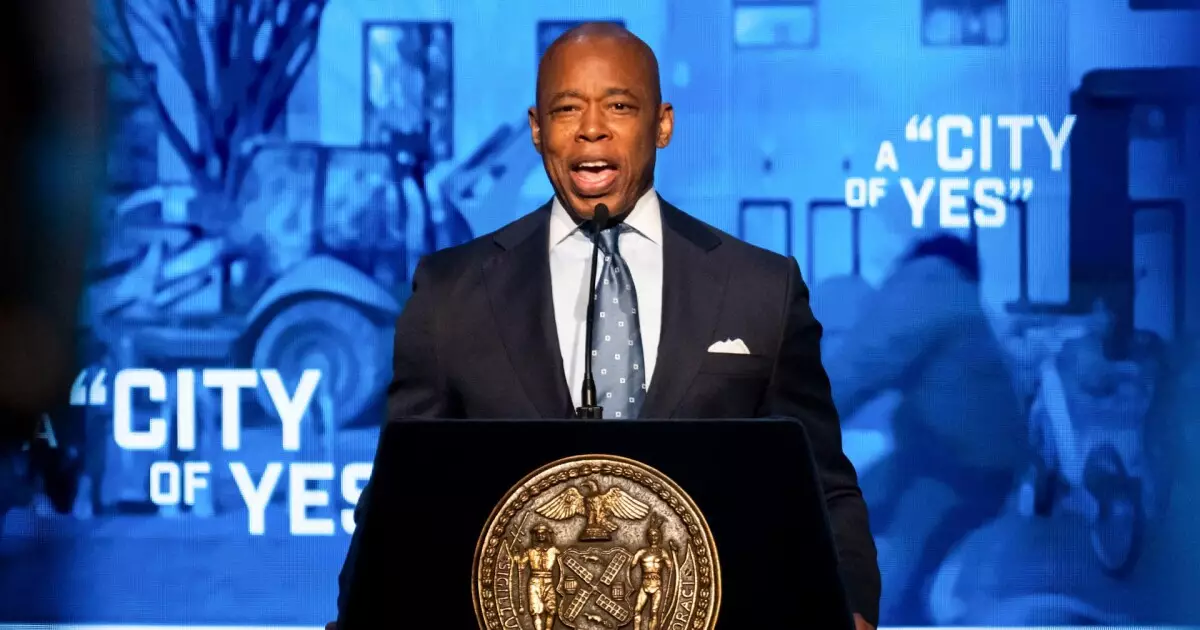In an impressive display of fiscal optimism, New York City Mayor Eric Adams has announced a $114.5 billion budget for the upcoming fiscal year, which commences on July 1. This proposal is notably larger by over $2.5 billion compared to last year’s budget and reveals an ambitious intent to boost social services through substantial new spending. The plan’s approval from the City Council is necessary, but its unveiling marks a significant shift in Adams’ fiscal strategy as it does not propose cuts or emphasize finding savings, a departure from past budgeting approaches.
Adams attributes this leap in spending potential to improved financial management within his administration and a surprisingly robust local economy. Following a tumultuous period of post-pandemic recovery, in which projected costs for migrant-related services were routinely overestimated, the city is now in a position to invest heavily in the community. Critics argue, however, that this budget is merely a correction of prior overly cautious fiscal disciplines rather than a sign of newfound economic confidence.
Central to the budget’s growth are the unexpected cost savings related to managing the influx of over 230,000 migrants since April 2022. Adams’ administration initially predicted spending could reach $12 billion by this July for migrant services, but the actual costs have fallen to $6.91 billion as of December. Insights from City Council Finance Committee Chair Justin Brannan contextualize this as a vindication of efforts to advocate for realistic budgeting from the start. The city’s successful renegotiation of contracts for migrant services and limitations on shelter durations reflects a strategic shift aimed at curbing expenses while still providing essential support.
The reduction in the number of migrants residing in city shelters—down from 69,000 to fewer than 50,000—signals a successful pathway to managing an enormous challenge that had previously strained city resources. Adams’ administration was quick to highlight these operational successes, portraying the revised financial outlook as a victory against prior miscalculations regarding the migrant crisis.
While there are projections of an additional $3.1 billion in tax revenue, primarily driven by business tax receipts, the budget does not lean into unbridled optimism. The mayor’s assertions about tourism potentially returning to pre-pandemic levels and a reduction in commercial property vacancies offer a cautious optimism about the city’s economic recovery. Yet these forecasts are tempered by the reality of the $4.2 billion deficit anticipated for fiscal 2027—a warning that the city must not become complacent, especially as long-term fiscal challenges loom on the horizon.
Despite the upbeat revenue forecast, concerns linger regarding the implications of potential shifts in the federal administration, particularly if political tides change significantly. Deputy Mayor Fabien Levy indicated that the city is preparing for any consequences from a shift in federal support, emphasizing the importance of maintaining a collaborative approach with the current administration. Such insights highlight the precariousness of municipal funding heavily reliant on federal assistance, with the city vulnerable to potential policy shifts.
Among the initiatives earmarked in the budget is Mayor Adams’ “Axe the Tax” proposal, which seeks to eliminate city income taxes for families below 150% of the federal poverty line. This initiative, with an estimated cost impact of $63 million annually, aims to lighten the fiscal load on the most vulnerable citizens. However, while this plan garners favorable public sentiment, it raises questions about the long-term sustainability of such tax reliefs amid growing budget concerns.
Additionally, the intent to allocate $2.6 billion in the current fiscal year specifically for city services is accompanied by a notable increase of $554 million earmarked for shelter costs. The rising number of homeless individuals—non-migrants arriving from other states—indicates that challenges remain in addressing the city’s broader social needs, further complicating the budget dynamics.
The Road Ahead: Navigating Uncertainty with a Hopeful Vision
As Mayor Adams navigates the complexities and uncertainties of urban governance, his latest budget proposal reflects both a hopeful vision for New York City and an acknowledgment of the difficulties that lie ahead. Shifts in fiscal priorities, ongoing challenges related to immigration and homelessness, and the ever-looming question of sustained federal support present an ongoing balancing act for the administration. The path forward will require meticulous attention to both immediate fiscal needs and strategic long-term planning as the city’s dynamic landscape continues to evolve.


Leave a Reply